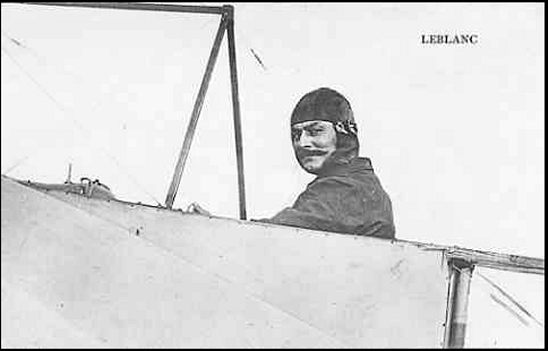
1869-1921 |
 |
|
Collection of Dave Lam |
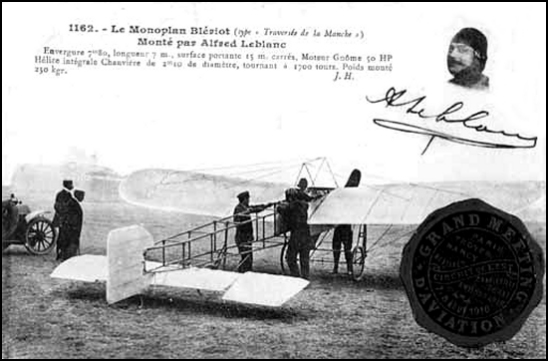 |
|
monté par Alfred Leblanc Scale 7m80, length 7m, airfoil 15m2, driving Gnôme 50HP. Integral propeller Chauvičre of 2m10 of diameter, turning with 1700 turns. Weight assembled 230kg. |
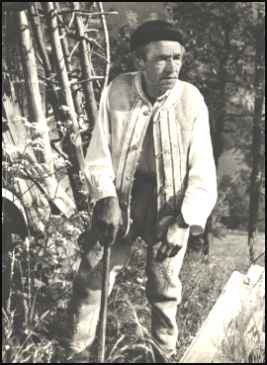 |
|
Collection of Eugen Kralcak, 5-1-06 |
|
Collection of Eugen Kralcak, 5-1-06 For the English Version, click on the title. Zasielam aj dve fotografie. C(íslo 1. je oc(itý svedok Ondrej Kralc(ák. C(íslo 2 je vrch Kozinec, z južnej strany, kde bol balón zachytený pred tým než zmizol v oblakoch. Alfréd Leblanc a jeho spoloc(ník odcestovali vlakom do Francúzka. |
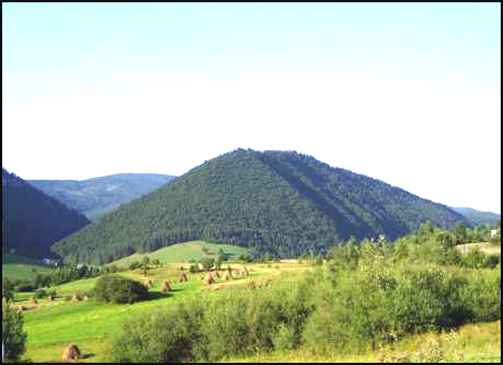 |
|
Collection of Eugen Kralcak, 5-1-06 |
|
Daily Journal and Tribune, Knoxville, Tennessee: August 18, 1910, Transcribed by Bob Davis - 9-4-03 Parisians Forsook Their Beds Early Wednesday Morning, To Witness Finish of the Cross-Country Race. Winner's Time For the 485 Miles Traversed Was 11 Hrs., 55 Min., 59 Seconds - Paris, Aug. 17. "LeBlanc's flight from Amiens, some sixty miles, was made in the same superb style as the previous laps in the race. He left Amiens at 5:03 and descended at Issy in the suburbs of Paris, one hour and twenty-eight minutes latwer, making the total time for the 485 miles of the entire flight eleven hours, fifty-five minutes and fifty-nine seconds, an average of nearly forty miles an hour as the crow flies, without making any allowance for detours or for the time spent in battling with the storm in the flight from Mezieres to Douai last Friday. "Aubrun, whose time from Amiens was one hour and fifty-one minutes, completed the circuit in thirteen hours, twenty-seven minutes, fourteen seconds. None of the other competitors completed the entire course, though Le Gagneux, who was forced to retire in the early stages of the race, finished with LeBlanc and Aubrun. "There was a moment of tumultuous cheering as LeBlanc appeared above Issy in the early dawn and from the height of nearly a quarter of a mile planed down toward the earth and swooped across the line like a giant hawk, alighting with the ease and grace of a big bird. "The authorities in expectation of the large crowd, had cordoned the alighting place at Issy with hundreds of police, backed by a regiment of culrassiers of long experience in handling the Parisian crowds. Nevertheless, the spectators in an irresistible gush broke through the line of culrassiers and police and bore the victor on their shoulders to General Brun, the minister of war, who, with his staff and other high officials, had appeared at the finish to welcome the victor. General Brun congratulated LeBlanc heartily in the name of the government. A military band struck up "The Marseillaise," but the music could scarsely be heard above the cheering of the crowd, which was echoed from the housetops throughout the vast city. Aubrun Arrives "Before the cheering for LeBlanc had commenced to die down, Aubrun, in his monoplane, shot into sight at the very point in the sky where LeBlanc had first been seen, and following the victor's wake, crossed the line and made an equally graceful landing, giving fresh impetus to the cheering. "In close succession to LeBlanc and Aubrun came LeGagneux and five army officers who had acted as escorts to the contestants in the last stage of the flight, the successful trip of eight aeroplanes across the country simultaneously and under pre-arranged conditions demonstrating to what extent the conquest of the air had been carried. "Such a gallery of spectators has never before been seen in Paris, nor has the scene been duplicated at any other place. Eiffel Tower was chosen as a point of vantage by crowds of spectators and the towering steel structure, like the housetops and other elevateed points in the city, was black with people watching the finish through field glasses or with straining eyes. "On the field at Issy, where the aviators finished, 200,000 spectators had gathered, the crowd including Prince Roland Bonaparte, General Dalstein, the military governor of Paris, and hundreds of distinguished men and women, who, when LeBlanc's monoplane was first sighted as a black speck high above the city, were seixed with a perfect delirium. Dangers of the Course "LeGagneux and the military aviators were forced to take landings on the trip from Amiens interfering with their plans to convoy in the winning aeroplanes. LeGagneux, in landing at Issy, broke a wing of his bi-plane. "LeBlanc and aubrun agree that the chief difficulty in flying across country is furnished by strong air currents and eddies over valleys and ravines along the course, which often suck down the aeroplanes from 200 to 300 feet without warning in an abrupt drop. During such experiences the aviators were able to keep their places in the machines only by clinging to the levers and framework. "Issy was also the goal for the big dirigible balloon Bayard-Clement, which arrived from Creil a short time after the bevy of heavier than air machines had alighted. Its arrival caused a further burst of cheering." Bob Davis |
|
AMIENS, FRANCE, AUGUST 16, 1910 Daily Journal and Tribune, Knoxville, Tennessee: August 16, 1910, Transcribed by Bob Davis - 9-2-03 Hubert Latham flew today from Issy Les Molineaux in the suburbs of Paris to Amiens, stopping en route to take lunch with friends at Breteuil. He thereby accomplished practically the last in the cross-country race, a distance of about sixty-eight miles, but in the reverse direction. The website you referenced had this entry for the same flight: 14/08/1910 Flew from Chalon-Paris-Issy. Issy-Chartres. Chartres-Deauville-Harve. Harve-Issy. Issy-Bretenil-27short Amiens. Repair aircraft flew to Amiens. Rights off aircraft at Amiens. 6 days of flying." Bob Davis |
|
|
|
|
|
Of special interest are several references to Alfred Leblanc. He was associated with Louis Blériot at the time of his successful crossing of the English Channel. To find the two references, you may want to use the "FIND" button on Leblanc. You can access the site by clicking on the title above. |
|
"The beginning of the flying activity in Ghedi was in 1909 when in the moor on the border with Montichiari was organized an airshow of international importance which saw the participation of airmen such as Wright, Calderara, Cobianchi, Cagno, Rougier, Curtiss, Moucher, Lebland, (Alfred Leblanc?), Anzani and Blériot, who won the "Brescia Grand Prize" flying 50 Km. in 49.24" with a biplane aircraft, while Curtiss won the height race reaching 92 metres. Among the spectators were numbered the Princess Letizia Savoy Bonaparte, Franz Kafka, who acted as foreign correspondent for a newspaper, and Gabriele d'Annunzio, who flew as passenger on Wright's airplane and that would later make of aviation one of his greatest passions (very famous remained his "Flight over Vienna")." To access the site, just click on the title above. |
|
This is a really remarkable resource and you should plan to visit each of the other nine pages so as to enjoy the many other postcards. . My sincere thanks go to Denís for his courtesy in allowing me to use images from his website to enhance the pages on this site. You can access his site by clicking on the title above. |
|
via email from Don Fiore - 9-1-03 |
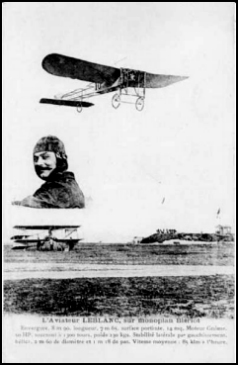 |
|
Collection of Dave Lam |
|
|
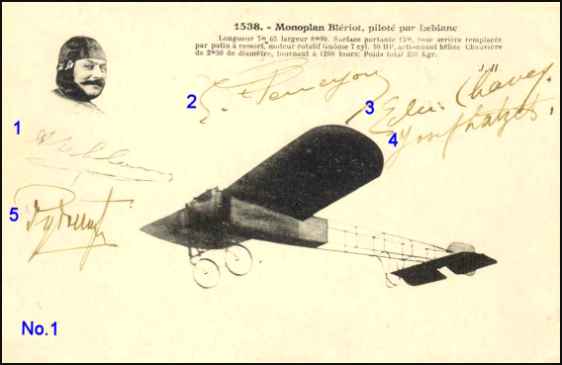 |
|
|
|
|
|
No. 1 2 3 4 5 |
Aviator Alfred Leblanc Edouard Perryon George Chavez Josef Latzel? ? |
French License 17 311 32 700 |
Contributor Lam Lam Lam Lam |
|
Personal communication from Adrien Tousch Editor's Note: If you have any information on this pioneer aviator please contact me. E-mail to Ralph Cooper |


|